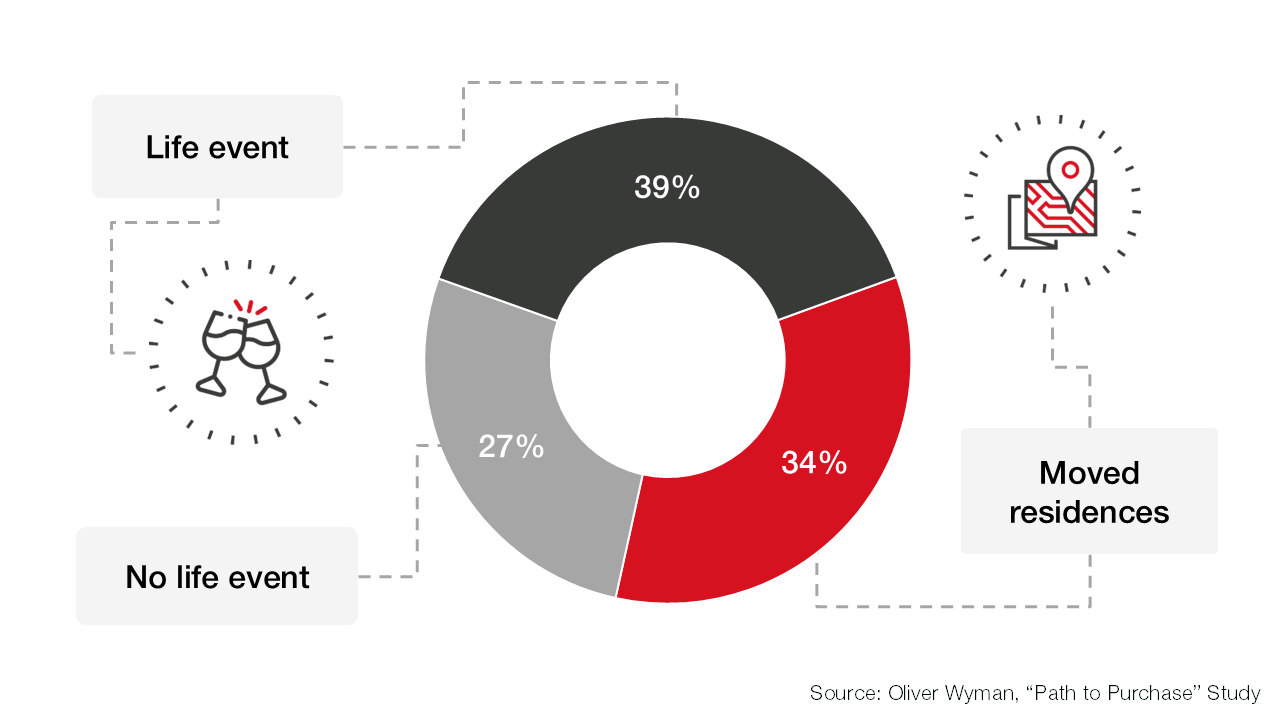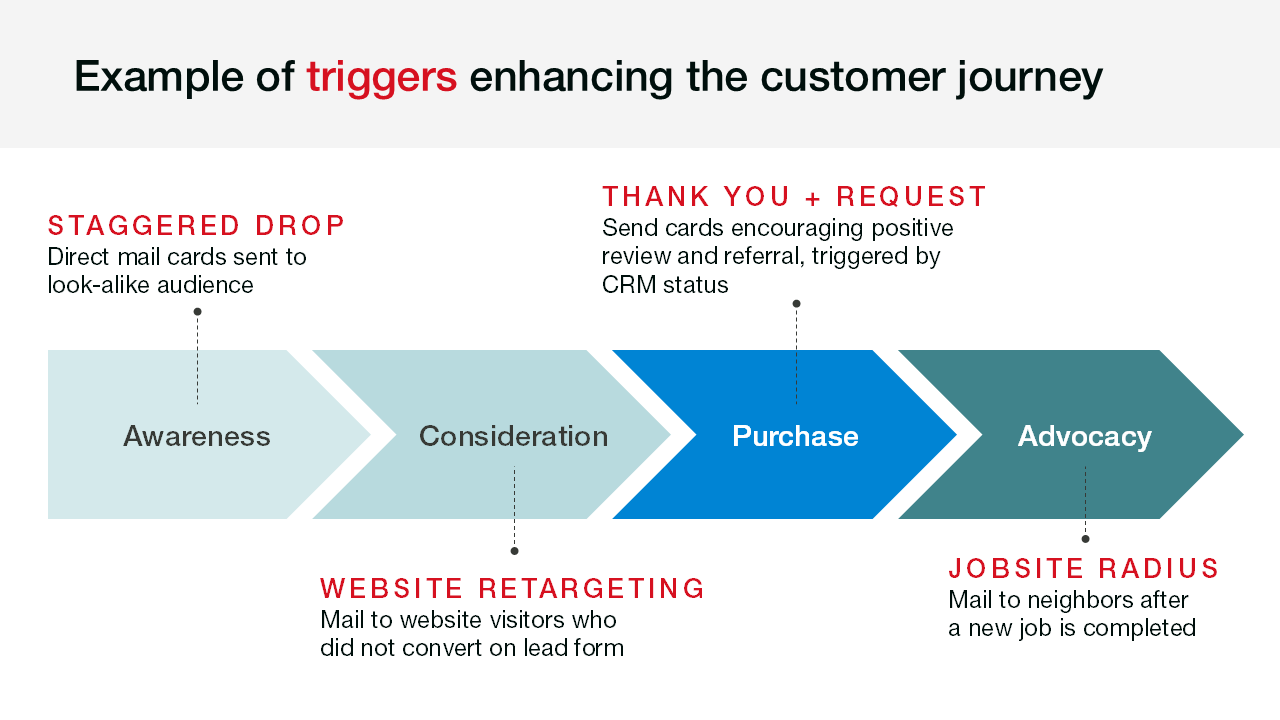The ability to reach the right person at the right time with the right message has become increasingly critical – and this is where trigger marketing proves its value. By leveraging life event triggers, marketers can effectively target consumers at key life stages, ensuring that their messaging aligns with customers' journeys.

The power of event triggers
Life events, such as moving homes or welcoming a new baby, are pivotal moments in consumers’ lives. One study revealed that over 70 percent of brand switches occur during major life stages like these. For marketers, this opens up a golden opportunity to engage with consumers when they are most receptive to new messaging.

While there is more willingness to switch brands or try new products during life’s milestones, in the mind of the consumer, not all products, brands or services are up for grabs. It's been reported that during a move, consumers are more likely to consider a new internet or streaming service provider and are least likely to consider switching to a new pet care provider or moving service company. Craig Salveta, Director of Consumer Acquisition Marketing at Lumen Technologies, confirms this trend.
“We target new movers, who are often very intent on finding a new internet service provider, usually on day one,” Salveta shared. “Our goal is to target them during that decision stage before they move into their new home.”
Internet and streaming services aren’t the only businesses poised to benefit from trigger marketing. New mover targets help enhance outreach across various industries, from banking to retail. Betsy King, AVP and Senior Marketing Manager at Byline Bank, finds trigger marketing especially attractive because it helps financial institutions reach prospects at the moment they’re most likely to consider switching primary banks.
“We’ve been doing batch direct-mail programs on a pretty consistent basis,” King shared. “But as anyone knows who has executed these programs knows, it’s a very expensive channel.” King went on to share that her team explored layering trigger marketing into this program for two reasons: first, to determine if triggers could help drive acquisition of new customers, and second, to test and see if triggers could increase the efficiency of the channel; she reported that both came to fruition.
“Having access to data for prospects who were more likely to convert helped us make trigger marketing an effective addition to our direct mail suite of tactics,” King concluded.
How triggers can enhance existing strategies
Every marketing channel has a specific role, and expecting a channel to do the wrong job can lead to missed opportunities – a concept that Chris Foster, VP of New Business Development at Modern Postcard, full-heartedly believes.
“Trigger marketing has a very specific job of reaching prospects based on their behavior,” Foster shared. On the other hand, large-scale direct mail campaigns serve a different purpose – focusing on demographics, interests and audience profiles, using volume to drive responses.
The key, Foster explains, is using these approaches in tandem. “For example, you can have a trigger program based on retargeting, but you can also do a large acquisition program based on behaviors, characteristics and demographics of your audience – it can work both ways.” When combined strategically, these methods help create a more comprehensive and effective marketing strategy.
Effective trigger programs and customer journey
Effective trigger programs are not just about reaching consumers; they're about enhancing the entire customer journey. By aligning messaging with customer needs and using creative storytelling, businesses can humanize their marketing efforts and create a more meaningful connection with their audience.

Foster further explained how his company has leveraged triggers to enhance multiple steps in the customer journey. Instead of a traditional batch mailing approach, Modern Postcard has implemented a staggered drop, sending a small number of mailers daily based on audience behavior, home value and location.
“Instead of mailing 10,000 cards,” Foster shared, “You can mail 100 cards a day for 100 days and create a steady cadence for that customer.” This strategy has resulted in an impressive return on ad spend; additionally, they used retargeting for website visitors who didn’t convert initially, generating an even greater return on revenue.
This staggered campaign extended beyond the initial sale, incorporating thank-you and referral cards, followed by job-site radius mailings to nearby homes, which further helped drive new business. A strategy like this goes to show that smaller businesses don’t necessarily need large budgets for effective direct mail campaigns; by using targeted, manageable trigger-based mailings, businesses can optimize spending while earning strong results at every stage of the customer journey.
Retargeting and creative messaging
As demonstrated by this staggered-drop strategy, retargeting plays a crucial role in trigger marketing, especially in industries like retail where consumer interest needs to be reignited. While retargeting with digital marketing messages has the benefit of fast delivery, it can also come at a higher cost than retargeting via direct mail. By mixing branded storytelling with engaging creative, digital mail retargeting may help to stand out against larger competitors while making a personal connection with the receiver.
Advice for trigger marketing beginners
For those starting in trigger marketing, understanding your goals and the consumer's life stage is crucial.
“My first piece of advice is just understanding your goals and what you're trying to accomplish, Salveta shared. “That's really critical from both a messaging perspective and for creating empathy and value with customer.”
Testing and learning are essential, too, and marketers should not be afraid to fail, as these experiences provide valuable insights for future campaigns.
“Don't be afraid to test and learn,” King explained. “Whether it's different types of creative or capabilities – like incorporating trigger marketing into your suite of tactics – don’t be afraid to fail. If you try it and it's not something that works, that's totally fine. We only learn what's best from a marketing-tactic perspective if we also understand what doesn't work.”
“Be really patient,” Foster advised. “Don’t think of trigger marketing as a one-off campaign that runs for a couple months and, if it doesn't meet objectives, gets canceled. Trigger marketing is more sustained, more ongoing. It's a marketing channel – you just have to give yourself time to figure it out and make the right adjustments.”
Trigger marketing is designed as an effective tool for engaging customers at pivotal moments in their lives. By focusing on real-time triggers and aligning messages with the customer journey, businesses are better positioned to enhance their marketing strategies, which can lead in remarkable results. As the industry continues to evolve, those who master trigger marketing will undoubtedly be more likely to lead the charge in customer acquisition and retention.
RECOMMENDED RESOURCES




